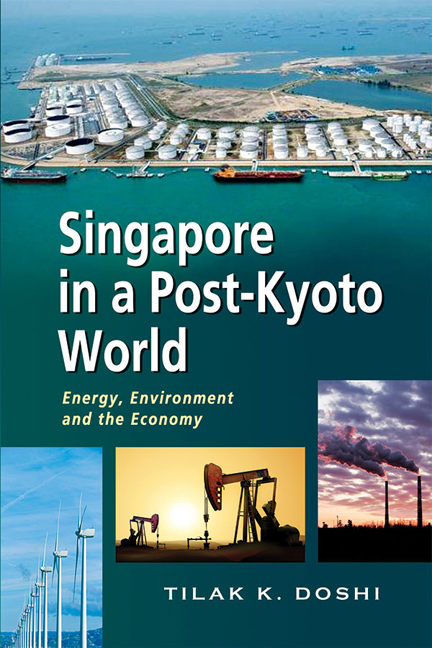Book contents
- Frontmatter
- Dedication
- Contents
- List of Tables and Figures
- Preface
- Acknowledgements
- List of Abbreviations
- Introduction
- 1 Economy, Energy, and Emissions
- 2 Climate Change Negotiations: From Copenhagen to Durban via Cancun
- 3 Climate Change Finance: Who Pays and Who Receives?
- 4 Singapore's External Sector: Impacts of Emission Mitigation Policies
- 5 Energy and Emissions: The Five Strategies
- 6 Concluding Remarks: “The Three E's”
- Index
- About the Author
5 - Energy and Emissions: The Five Strategies
Published online by Cambridge University Press: 19 May 2017
- Frontmatter
- Dedication
- Contents
- List of Tables and Figures
- Preface
- Acknowledgements
- List of Abbreviations
- Introduction
- 1 Economy, Energy, and Emissions
- 2 Climate Change Negotiations: From Copenhagen to Durban via Cancun
- 3 Climate Change Finance: Who Pays and Who Receives?
- 4 Singapore's External Sector: Impacts of Emission Mitigation Policies
- 5 Energy and Emissions: The Five Strategies
- 6 Concluding Remarks: “The Three E's”
- Index
- About the Author
Summary
It is commonly observed that the growing complexity and strategic importance of energy policy demands a “Whole-of-Government” approach, where specialized ministries and agencies work in a coordinated way across multiple jurisdictions to implement policy. The work of integrating the different strands of Singapore's energy policy was institutionalized with the establishment of the Energy Policy Group (EPG) in March 2006. Led by the Ministry of Trade and Industry (MTI), it comprises key ministries, including Environment and Water Resources (MEWR), Foreign Affairs (MFA), Transport (MOT) and Finance (MOF), and agencies like the Energy Market Authority (EMA), Economic Development Board (EDB), National Environment Agency (NEA), Land Transport Authority (LTA) and Building and Construction Authority (BCA). The EPG plays the role of formulating and coordinating Singapore's energy policies and strategies. In addition to the development of a national energy policy framework, the EPG studies a wide range of energy issues, which include power and transport sectors, energy efficiency, climate change, energy industry, energy research and development (R&D), and engaging in regional and international energy policy cooperation. Coordinating the efforts of all stakeholders will be a constant feature in Singapore's energy policy efforts in the future.
Singapore's national energy policy framework strives to achieve a balance among three objectives, namely retaining economic competitiveness, enhancing energy security, and protecting the environment. In a report released in 2007, MTI identified five strategies under the country's energy policy framework: promoting competitive markets, diversifying energy sources, enhancing energy efficiency, developing the energy industry and investing in energy R&D, and stepping up international cooperation.
PROMOTE COMPETITIVE MARKETS: GETTING PRICES RIGHT
Singapore has come a long way from its early role in the 1890s as a storage and trans-shipment centre for kerosene in the colonial Far East. The first bulk oil cargo destined for Asia was loaded on to the Samuel brothers’ storage tanks in Pulau Bukom in 1892; the vessel Murex brought the cargo from Batum, an oil port in the Black Sea, via the Suez Canal, which was newly opened to oil traffic. Shell established a strategic Far East distribution site for refined oil products with a storage facility in Pulau Bukom, an offshore island south of the main Singapore island.
- Type
- Chapter
- Information
- Singapore in a Post-Kyoto WorldEnergy, Environment and the Economy, pp. 168 - 270Publisher: ISEAS–Yusof Ishak InstitutePrint publication year: 2015

